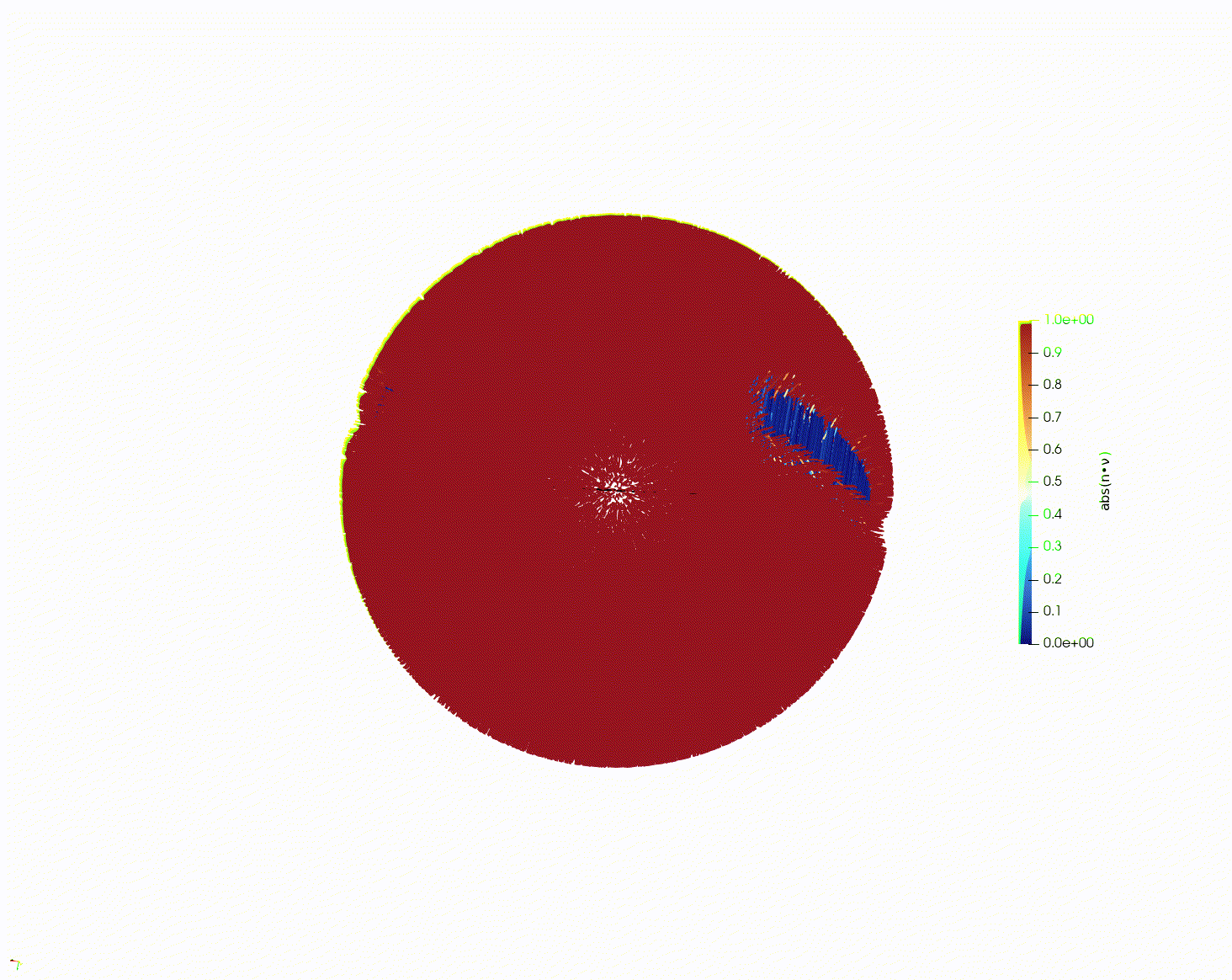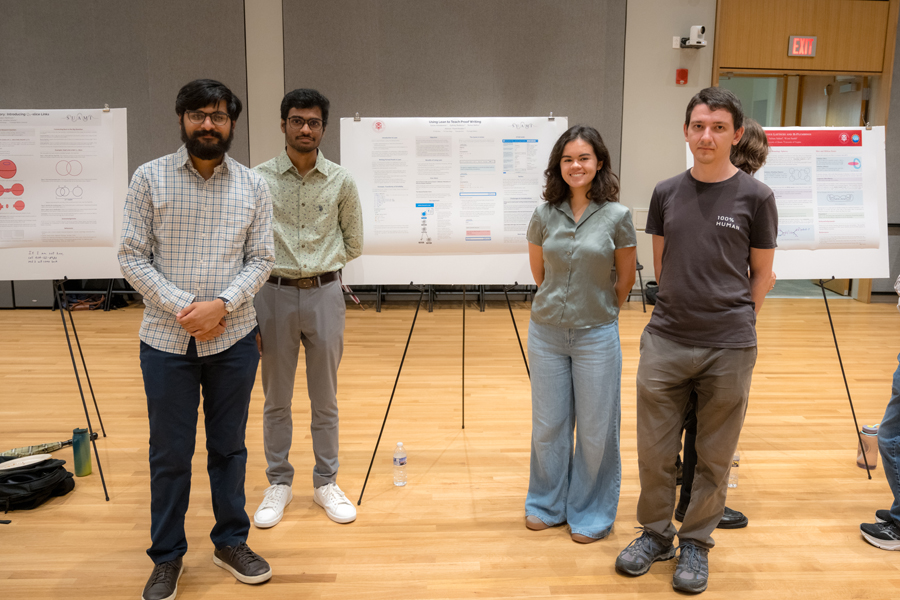Summer Undergraduate Applied Mathematics Institute
May 27 - July 19, 2025
Projects
► Rationally $\chi-$slice links, Kalev Martinson
Advisor: Jonathan Simone
Abstract: A knot in $S^3$ is called slice if it bounds a smoothly properly embedded disk in the 4-ball $B^4$. A knot is called rationally slice if it bounds a smoothly embedded disk in some rational homology 4-ball (which is a 4-dimensional manifold with the same rational homology at $B^4$). A link (which is a collection of knots tangled together) is called $\chi-$slice if it bounds a smoothly properly embedded surface in $B^4$ with no closed components and Euler characteristic 1.
The notions of rationally sliceness and $\chi-$sliceness are both generalizations of sliceness in the following way: every slice knot is rationally slice; and every $\chi-$slice knot is slice. The objective of this project is to combine these two generalizations of sliceness; we define a link to be rationally $\chi-$slice if it bounds a property embedded Euler characteristic 1 surface with no closed components in some rational homology 4-ball. We also define the rational $\chi-$concordance group, which serves as a generalization of both the rational concordance and link concordance groups which are well-known in the literature.

We then turn to showing that these new concepts are nontrivial and warrant study. To this end, we develop methods that can be used to show a given link is not rationally $\chi-$slice and use it to show that not all links are rationally $\chi-$slice. We then use geometric arguments to show that there exist infinitely many rationally $\chi-$slice links with more than one component that are not $\chi-$slice; hence the notion of rational $\chi-$sliceness contains as a proper subset all rationally slice knots and $\chi-$slice links.
► H-plumbings bounding rational homology 4-balls, Sabian Saliasi and Wynn Smith
Advisor: Jonathan Simone
Abstract: An H-plumbing is a 3-dimensional manifold that can be described diagrammatically using a weighted graph whose vertices and edges make the shape of an H and such that each vertex has weight that is at most negative the valence of the vertex. Such 3-manifolds have the same rational homology as the 3-dimensional sphere and are called rational homology 3-spheres; these are topologically simple 3-manifolds (as measured by homology). The simplest 4-manifold (as measured by rational homology) that a rational homology 3-sphere can bound is a rational homology 4-ball---a 4-manifold with the same rational homology as the 4-dimensional ball. For this project, we explore which H-plumbings bound rational homology 4-balls.
We first focus on H-plumbings with six vertices. Using the tools of lattice analysis and cubiquity, we obstruct all but finitely many of these H-plumbings from bounding rational homology 4-balls. We then show that the remaining H-plumbings with six vertices bound rational homology 4-balls by explicitly constructing them using diagrammatic arguments. Finally, we construct infinite families of H-plumbings (with an arbitrary number of vertices) bounding rational homology 4-balls using expansions.

► Using Lean to Teach Proof Writing, Suhas Alladaboina, Sydney Badescu, Rohan Bafna
Advisor: Pavel Kovalev
Abstract: We developed a Lean game using the Lean4 Game Engine that covers the first several chapters of Clive Newstead's An Infinite Descent into Pure Mathematics. This project involved creating new tactics that mimic the proof strategies presented in the textbook, helping to reduce the Lean learning curve. The game can serve as an optional supplement to help students become more comfortable with proof techniques.

► Modeling Liquid Crystals with Numerical PDEs, Cal Heldt, Yuzhi Liu, Steven Spasov
Advisor: Andrew Hicks
Abstract: Liquid crystals (LC's) are a material that has increasingly found many uses in our modern world, most famously in liquid crystal displays. This research looked into the behaviors of LC's through the lens of numerical PDE’s and the finite element method (FEM), using the Landau-de Gennes (LdG) model.
The students learned about the LdG model, including the mathematical prerequisites to understanding it. Then they wrote a code to simulate LC behavior using FEM in two dimensions. After this, they used an already written code to simulate LC behavior in three dimensions, in particular studying so-called “defects” in the LCs.

► Radio Labelings and the Moore bound, An Cao, Julian Hutchins, Orlando Luce
Advisor: Aleyah Dawkins
Abstract: First introduced by Hale in 1980, the frequency assignment problem (or channel assignment problem) addresses the challenge of assigning frequencies to transmitters such that interference is minimized. In 2001, Chartrand et al. formulated the radio labeling problem to model the frequency assignment for radio towers, with modern applications to cellular and satellite networks. For a simple, connected graph $G = (V (G), E(G))$, a radio labeling is a mapping $f : V (G) → Z^+$ satisfying for any distinct vertices $u$, $v$
$$|f (u) − f (v)| + d(u, v) \ge \mathrm{diam}(G) + 1,$$
where $d(u, v)$ is the distance between $u$ and $v$ in $G$ and $\mathrm{diam}(G)$ is the diameter of $G$. A graph is radio graceful if there is a radio labeling such that $f (V (G)) = \{1, . . . , |V (G)|\}$. We investigated the radio gracefulness of low-diameter graphs closely related to the Moore bound, including Moore graphs, bipartite Moore graphs, and approximate Moore graphs like $(r, g)$-cages, Erdős-Rényi polarity graphs, and McKay-Miller-Širáň graphs.

These low-diameter graphs are known to have applications in network design, particularly for high-performance networks. A necessary and sufficient condition for radio graceful bipartite graphs with diameter 3 was proved. Radio labelings of $(r, g)$-cages arising from generalized $n$-gons and Erdős-Rényi polarity graphs were found. The radio gracefulness of known $(r, g)$-cages was also considered, with the only radio graceful $(r, g)$-cages found being complete graphs and Moore graphs of girth 5 and 6.
Students
- Kalev Martinson, Georgia Tech
- Sabian Saliasi, University of Miami
- Wynn Smith, University of Virginia
- Orlando Luce, George Washington University
- Julian Hutchins, Morehouse College
- An Cao, Brown University
- Rohan Bafna, Georgia Tech
- Suhas Alladaboina, IIT
- Sydney Badescu, UCSD
- Steven Spasov, Columbia University
- Cal Heldt, University of Nebraska
- Yuzhi Liu, University of Michigan




Faculty
Aleyah Dawkins
Postdoctoral Associate
E-mail: adawkins@andrew.cmu.edu
Andrew Hicks
Postdoctoral Associate
E-mail: andrewhi@andrew.cmu.edu
Pavel Kovalev
Postdoctoral Teaching Fellow
E-mail: pkovalev@andrew.cmu.edu
David E. Offner
Associate Teaching Professor
E-mail: doffner@andrew.cmu.edu
Jonathan Simone
Assistant Teaching Professor
E-mail: jsimone@andrew.cmu.edu
Michael Young
Associate Professor
E-mail: michaely@andrew.cmu.edu